Starting from the Ladybower Inn car park, where we could hear a cuckoo calling from further up the valley, we followed the steep trackway up and into Ladybower Wood Nature Reserve – the start of the day was a bit cool and overcast but we could soon hear several willow warblers singing from within the reserve along with other familiar woodland birds – wren, robin, nuthatch, coal, blue and great tits. Stopping by the first wildlife spotting post, with the pull out panel showing some of the woodland birds you can look for, some of the volunteers began to reminisce about the work that they had carried out here – including the installation of signs and the annual bracken bash, whilst others, for who this was their first visit to the this reserve, learnt more about the site and its wildlife.
Sam's safari
Ladybower Woods, Guy Badham
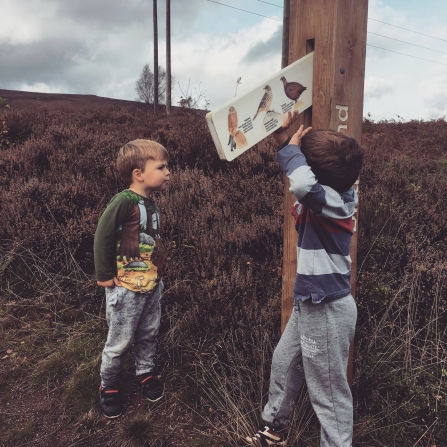
Ladybower Wood, Louise Baker
Ladybower Wood was purchased by Derbyshire Wildlife Trust way back in 1976 so is one of our oldest nature reserves, comprising of two thirds sessile oak woodland and one third heather moorland blanketing a steep boulder covered valley side. One of the few remaining pockets of upland woodland in Derbyshire this remains an invaluable space for several species, fauna and flora, which depend exclusively on this habitat. We meandered further into the reserve rediscovering its habitats and admiring some of our previous efforts. Looking through the moorland areas, we found cowberry in flower – looking closely at the perforated underside of its leaves, along with tormentil – another heathland flower – plenty of bilberry and heather too although not yet in flower. We ventured further to just inside the semi-ancient sessile oak woodland hoping for glimpses of redstart and pied flycatchers as they return to breed here each spring and summer. Retracing our steps slightly we headed out on to the open moor beyond the reserve and on towards Cutthroat Bridge for our mid- morning snack break.

Pied flycatcher, Margaret Holland
During our elevenses’ coffee break we were treated to excellent views of a female ring ouzel perched high on a near-by pylon repeating its “tac-tac-tac” call. We were delighted to see this bird as we had hoped to find one on our walk, an upland migrant bird slightly smaller than a blackbird with distinctive black feathers and a white breast band. Two willow warblers flittered about an old hawthorn tree not quite in flower right beside where we were sat, and a buzzard was seen trying to fend off an attack by a couple of carrion crows, a kestrel too was seen in its familiar hovering stance.
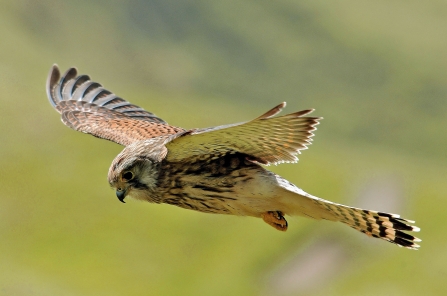
Kestrel, Steve Waterhouse
With break over we continued along the bridleway towards Derwent Edge – along the way we saw three mountain hares, still with the last remnants of their winter coat showing white on the backs of their ears and hind legs. Two of the Hares came within meters of our group as they chased each other and bounded over the moorland slopes, it was a real treat to see them so close. On closer inspection of the ground we saw many green tiger beetles which thrive on the drier soils of heathland, as well as several small copper butterflies. Overhead several curlews were flying and calling whilst lapwings defended their territories with their characteristic song flights and the odd red grouse was spotted strutting amongst the heather.
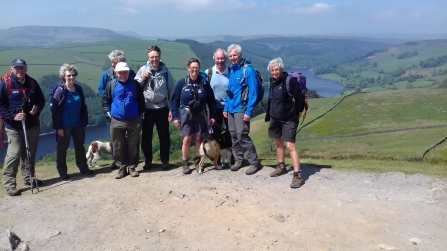
Volunteers on Sam's safari
We reached a great view point at the start of Derwent edge as the clouds began to disperse and temperatures started to rise. We paused here for a few moments to take in the fabulous views of Ladybower Reservoir and the Upper Derwent Valley and across to Win Hill and part of the Great Ridge. We continued on a path just below Derwent Edge that would take us down the hillside to the shores of the reservoir itself. On the way we heard the call of a golden plover and spotted green hairstreak butterflies. We found a spot as the trees started to stop for lunch, sharing some cakes and other picnic treats whilst soaking in the views.
After lunch we made our way down towards Ladybower Reservoir, just beyond the Stone Shelter we saw our first of what was to be 100’s of the intriguing cockchafer beetle – these are large, 3cm, flying beetles with distinctive pointed tails and brown metallic wing cases. Also known as ‘ May beetles’ due to the month they emerge, having spent three to four years as larvae in the soil up to 100cm deep in the ground they only have 5 to seven weeks on the wing and look clumsy in the air whilst they find food and a mate. Once abundant across Europe these beetles were considered a pest due to the damage caused to crops and were extensively exterminated, they are slowly making a comeback and can be seen “in-mass” some years perhaps correlating to their four year life cycle. We saw many of these beetles on the ground and in the air as we continued on the trail by the reservoir – seeming to be particularly attracted to the honeydew on the leaves on the large sycamore trees on the reservoir banks.
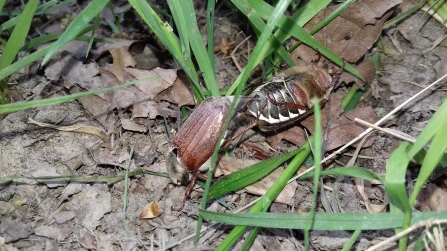
Cockchafer beetle, Sam Willis
A mix of flowers were studied as we passed a lovely meadow, including; lousewort, heath bedstraw, pignut, greater stitchwort, bulbous buttercup, bush vetch, red campion and lesser trefoil. There are many great examples of mosses, liverwort and lichens that can be found in this area as well. Several more butterflies were seen here too including large white, orange tip, green vein white, peacock and speckled woods. Alongside the reservoir, on the water edge we spotted a common sandpiper feeding on the gravel shore line and a mallard with ducklings swimming, along with Canada and pink footed geese further out. The woodlands here still had a good carpet of bluebells in full flower being that much further north in Derbyshire and with this year’s long winter the bluebells still linger here when elsewhere they are long over. Brightly coloured yellow pimpernel flowers were found in the shade of the trees alongside the path.
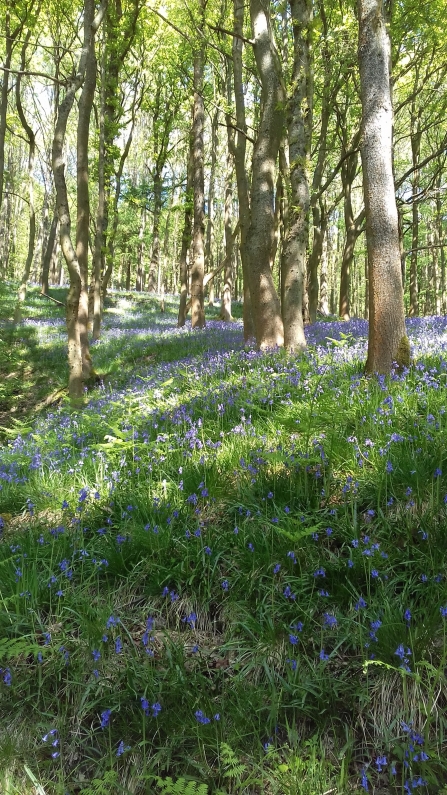
Bluebells at Ladybower, Sam Willis
On the final leg of the walk the clouds had completely dispersed leaving us with sunny blue skies to enjoy the fantastic views and wildlife we are so fortunate to have close to home. In all we saw 24 bird species, 12 fauna and 19 flora of note whilst enjoying a lovely walk and great company. Thank-you to all the volunteers who joined us on the walk – I hope you enjoyed it as much as we did. We would also like to extend our thanks to all our volunteers who do incredible work helping us look after our wildlife in Derbyshire.

